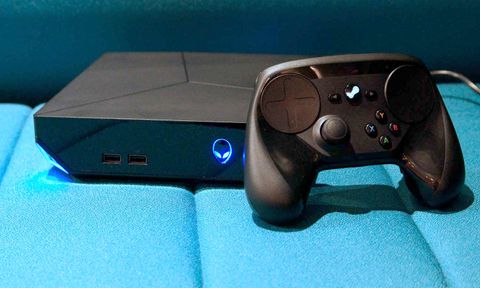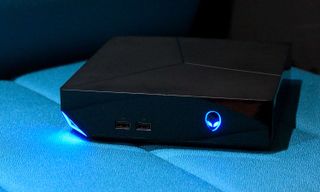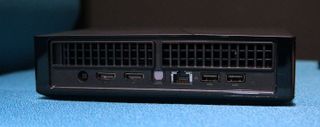Alienware Steam Machine Review
The Alienware Steam Machine has a gorgeous interface and powerful specs, but its game selection and extra features fall short.
Why you can trust Tom's Guide

At long last, Steam Machines have arrived, and gamers everywhere can get a full PC experience right from their living rooms — at least in theory. The Alienware Steam Machine ($450 - $750) is one of the most visible models of the new PC/console hybrids, and it successfully brings SteamOS and more than 1,000 games to big-screen TVs. Whether it's better than a cheap gaming desktop or game console, though, is up for debate.
The Alienware Steam Machine has a gorgeous interface and a respectable amount of power (depending on the model), and it offers a lot more flexibility than a standard game console. However, the game library still needs some work, there are still a lot of challenges in hooking up peripherals and it's missing tons of simple things that game consoles could already do years ago. The Alienware Steam Machine is a decent piece of hardware, but it's too limited to be your only gaming system.
Design
The Alienware Steam Machine is an attractive little box. At 7.9 x 7.9 x 2.2 inches, it's considerably smaller than either a PS4 (12.0 x 10.8 x 2.1 inches) or an Xbox One (13.1 x 10.8 x 3.1 inches), and much more compact than traditional gaming rigs. It's mostly squarish, with one triangular edge that has a blue Steam logo. It looks right at home next to a TV in an entertainment-center setup.

The device has plenty of ports, too. In addition to two HDMI ports (for multimonitor applications), there's a digital audio-out port, an Ethernet port, two USB ports in the back and two USB ports in the front. While it's not quite as robust as a true gaming PC, you can connect plenty of external speakers, keyboards, mice and controllers to it.
Interface
SteamOS is an attractive program that splits the difference between a game console interface and a traditional Linux computer. While it's easy to get around, it can feel a bit insubstantial.

If you've ever used Steam's Big Picture mode on Windows (or if you've installed SteamOS on another machine; it's a free operating system that you can install almost anywhere), the menus will look very familiar to you. You can access your game library, shop for new titles, fiddle with the settings or open up a Web browser. That's really about it.
It looks right at home next to a TV in an entertainment-center setup.
The navigation is much simpler than the PS4's and Xbox One's endless menus upon menus, although there's also not as much you can do with the system. There are no apps (more on that later), and if you want to access anything more complex than the basic system specs, you must use Desktop Mode, which feels like a no-frills Linux OS.
But SteamOS commits one major faux pas: It shows you every game in your Steam library on the Library page by default, rather than just the ones that work on SteamOS. You can change this easily enough with a filter, but unless you do, you have to scroll through each game and face the inescapable fact that most of them won't work unless you stream them from a PC.
Game Selection
One area where SteamOS is still trying to catch up to Windows PCs is in its game selection. (Comparing it to dedicated game consoles is more of a mixed bag. While SteamOS can run more than 1,500 titles, they tend to be at least a few years old. Consoles have much smaller libraries but also host new releases the day they come out.)
I found that the gameplay was smooth and seamless, whether I was slaying Orcs as Talion the Ranger or wreaking havoc all across Sweden as a destructive goat.
SteamOS does have a lot of quality games. Counter-Strike, Dota 2, Portal, Hotline Miami, Bastion, Borderlands 2, Shovel Knight, Middle-earth: Shadow of Mordor, Bioshock Infinite, Psychonauts and many more beloved titles are fully compatible (although some of them require you to assign your own button shortcuts to the Steam Controller).
But although the game selection is huge, having a PS4, an Xbox One or a Windows PC will allow you to get hot new releases much sooner. There's no Grand Theft Auto V, no Assassin's Creed Syndicate, no Fallout 4, no Metal Gear Solid V and no Call of Duty: Black Ops III. If SteamOS really takes off, these popular games might get ports eventually, but you could also buy any other system and play them right now.
MORE: Best Gaming Desktops
The Alienware Steam Machine does have one powerful mitigating factor, however: the ability to stream almost any game (Steam or otherwise) from a Windows PC. The ability to bring any PC game you wish into your living room is undoubtedly a useful feature (even though programming the Steam Controller to interact with non-Steam games can be a bit of a process). However, a $50 Steam Link will accomplish the same thing.
Gaming Performance
In terms of raw specs, the Alienware Steam Machine is comparable to a PS4 or an Xbox One, in that it has less RAM but a more powerful processor and GPU. I ran a variety of games on it, both on the system itself and streamed through a Windows PC. The overall performance was promising, but it took a little more tweaking than console players might be used to in order to get it right.
On SteamOS, I played through sections of Middle-earth: Shadow of Mordor, Borderlands 2 and (naturally) Goat Simulator. In theory, the Alienware Steam Machine is supposed to set every game to optimal settings when you launch it, but I found that it tended to err on the side of caution (720p resolution with most of the graphical settings on Shadow of Mordor turned to Low).

Most games ran just fine in 1080p with the settings turned up, but exactly which settings, and how far to turn them up, was a matter of some experimentation. For PC gamers, this will be nothing new, but console gamers may find it a bit time-consuming to spend 10 or 15 minutes tweaking graphical settings before diving into an adventure.
Out of curiosity, I also tried Shadow of Mordor on a 4K monitor. The GPU is not really built to handle 4K resolutions, but the game still played at about 30 fps, at least with all the other settings turned down. Once I started upping the textures and lighting, the game started to look more like a slideshow. It's fair to say that, despite its merits, the Alienware Steam Machine is not a 4K powerhouse.
There's no Grand Theft Auto V, no Assassin's Creed Syndicate, no Fallout 4.
Once the settings were right, I found that the gameplay was smooth and seamless, whether I was slaying Orcs as Talion the Ranger or wreaking havoc all across Sweden as a destructive goat. The Steam Controller itself caused more than a few hiccups, so new users should be aware that the peripheral has a steep learning curve.
Streaming games from Windows was also a simple and pleasant experience, albeit one subject to occasional lag and screen tearing. How well it works will depend on your own network setup, and SteamOS recommends using a wired connection. (However, that might not be possible; after all, if your computer were that close to your TV, why not just hook it up directly?)
Controllers
The Alienware Steam Machine comes equipped with a Steam Controller, which is a love-it-or-hate-it proposition. While the peripheral is a competent product, it's also extremely different from other console controllers, and not always in a positive way. The Steam Controller has two large haptic pads where an analog stick and face buttons would usually be, and moves those stick and buttons down to the bottom of the device.

The haptic pads are fantastic for navigating websites and the on-screen keyboard, but they're not quite as intuitive for selecting units or controlling a camera in-game. The Steam Controller is novel and functional, and it's worthwhile to invest the time in learning how to use one. As for whether it's easier to use than a keyboard and mouse, or a traditional controller, for most people, the answer is probably "no."
One great feature of the Alienware Steam Machine is its ability to work with a range of peripherals. While it works with the Steam Controller wirelessly by default, you can also just plug in an Xbox One controller, a mouse, a keyboard, a joystick, a motion controller or whatever else you wish to use. There's a good chance that the box will recognize whatever you plug into it, as long as it uses standard USB drivers.
Unfortunately, this box doesn't work perfectly with anything that's not a Steam Controller. You can get Xbox 360 and Xbox One controllers to work wirelessly, but it takes a little Linux know-how. (Wired configurations are fine.) Programs like the Logitech Gaming Software and Razer Synapse 2.0 don't work on Linux, which means that gaming mice will be stuck at a predetermined DPI (dots per inch), and keyboards will have no macro or lighting options.
MORE: Valve Steam Controller Review — Master of None
This also means that it might take some finagling to get mice and keyboards that require wireless dongles up and running, unless they have Linux support out of the box. For a living room PC setup, you'll need either a little Linux expertise or some very long USB extension cables.
Still, I tested a number of different Logitech, Razer and Microsoft peripherals, and did not encounter any that did not work. It's a promising start, but it highlights the inherent problem with pitching Linux as an all-purpose gaming platform.
Internet Features
One of the best features of the Alienware Steam Machine is its full-featured Internet browser. Unlike the browsers on the PS4 and the Xbox One, it doesn't face many limitations. It can run sites like Netflix without defaulting to an app instead. This turns out to be a double-edged sword, as it means the Alienware Steam Machine does not possess any apps.
The Alienware Alpha offers the same experience, plus all the convenience of Windows 10.
Arguably, the system does not need dedicated apps for services like Netflix, Hulu, Pandora or Spotify, since you can simply navigate to each company's website and use it just as you would on a computer. However, over the past few years, users have grown accustomed to game consoles and other streaming devices offering refined, simple apps that are optimized for a controller rather than a mouse and keyboard. Yes, you can watch BoJack Horseman in 1080p on a Steam Machine, but not in an optimized way.
Configuration Options
The Alienware Steam Machine comes in four different configurations at four different prices. The cheapest ($450) comes with an Intel Core i3 processor as well as 4GB of RAM and a 500GB hard drive. Each of the other three models comes with 8GB of RAM and a 1TB hard drive. A $550 model uses an i3 processor, a $650 model uses an i5 processor and a $750 model comes with an i7 processor. We reviewed the i7 version.

Processing speed is important, but the GPU is what will really define your SteamOS gaming experience. As such, each model of the Alienware Steam Machine comes with an Nvidia GeForce GTX 2 GB GDDR5 card. This isn't directly comparable to any of Nvidia's regular cards, although it's similar to the GTX 860M overall.
Although the Alienware Steam Machine is not a true PC, it still has some upgrade options. The CPU and GPU are set in stone, although it seems possible to upgrade the RAM and hard drive, if you're so inclined. Each model also comes equipped with a Steam Controller.

While the machine won't redefine anyone's gaming experience, it has perfectly respectable guts for a living room gaming machine. Still, the price is enough to raise an eyebrow. Both the Xbox One and the PS4 are arguably more powerful, but cost only $350 or $400 apiece, depending on hard drive options (or even less, if you can catch a frequent sale).
Furthermore, the Alienware Alpha, which is a Windows PC in the same shape, costs exactly the same as the SteamOS version. Theoretically, you could buy an Alpha, run Steam in Big Picture mode (or even install a secondary SteamOS boot) and have exactly the same experience, plus all the convenience of a Windows 10 OS.
Bottom Line
The Alienware Steam Machine is full of contradictions. It's more expensive than a standard console, but not universally more powerful. It has thousands of games, but not necessarily the ones you'll want to play. The performance is great, but also exactly what you'd expect for a modern living room system.
I've been racking my brain to come up with who should buy an Alienware Steam Machine, and I can't come up with a definitive answer. For a first-time console buyer, a PS4 or an Xbox One (both $350) would be a much more intuitive and affordable choice. For a hardcore PC gamer who wants a living room experience, an Alienware Alpha or even a Steam Link would fit the bill much better. In the end, the Alienware Steam Machine faces the unusual problem of filling a niche as well as it can, but not making it clear why the niche needs to be filled.
Sign up to get the BEST of Tom's Guide direct to your inbox.
Here at Tom’s Guide our expert editors are committed to bringing you the best news, reviews and guides to help you stay informed and ahead of the curve!
Marshall Honorof is a senior editor for Tom's Guide, overseeing the site's coverage of gaming hardware and software. He comes from a science writing background, having studied paleomammalogy, biological anthropology, and the history of science and technology. After hours, you can find him practicing taekwondo or doing deep dives on classic sci-fi.
